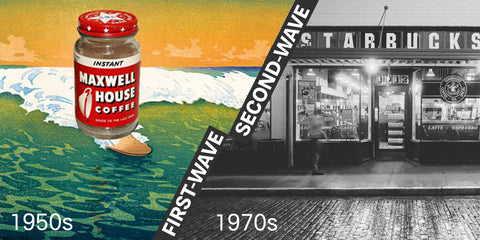
You have probably heard the term ‘third-wave’ coffee mentioned frequently in blogs, magazines and perhaps at your favourite café down the street. But what does it actually mean? And how is it different from specialty coffee?
A Brief History in Coffee
There are three fundamental movements that influence the consumption of what we call ‘Specialty Coffee’ today. The first-wave was marked by the proliferation of mass market ground coffee in large supermarket chains. This sparked off an exponential growth in coffee drinkers, turning coffee into the mainstream commodity we are familiar with today.
Consumers soon became more conscious about the quality of coffee they drink. The second-wave, led primarily by Peet’s Coffee and Starbucks in the United States, was when Arabica beans and espresso-based drinks were introduced to the market. Artisan-driven coffee drinks (such as latte, cappuccino, macchiato), coffee sourced from around the world and different roasting techniques were some of the key characteristics of the second-wave movement. There was also a heighten consciousness of the importance of the entire supply chain – where the coffee beans are sourced from (fair trade coffee) to handcrafted beverages prepared by skilled baristas.

The Third-Wave Coffee Phenomenon
"The third-wave is all about making the consumer feel special."
So what sets apart the third-wave? One of the major developments that coin the third-wave was the focus on the diversity of coffee flavours. Single-origin coffee (sourced from a single producer or farm) typically identified by their country, region and elevation they are grown, each showcase complex flavours unique to its origin. Coffee roasters also moved away from dark roasts to a lighter roast, allowing for the diversity of flavours to shine through the coffee.
Cafés also started to move away from automatic espresso machines to focus on the craft of brewing individual cups of coffee. Presentation with latte art was just as important as the quality of the coffee to create a multi-sensory experience that caters to the sophisticated tastes of specialty coffee drinkers. Third-wave baristas differentiate themselves from the second-wavers by their technique and knowledge, being able to tell you exactly when the coffee was roasted, how the beans were processed and also offer cupping notes. The third-wave is all about making the consumer feel special.
Another development of third-wave coffee is the innovation of brew methods – pour overs using Chemex, V60, Aeropress and French Press amongst others were used to highlight the distinctive tasting notes of single-origin coffee.

What is Specialty Coffee?
The focus on Specialty Coffee is also a significant part of the third-wave movement. The Specialty Coffee Association of America (SCAA) grades all coffee beans on a 100-point scale. Coffees that score 80 points and above are graded as ‘specialty’ for its exceptional quality influenced by specific microclimates, soil composition, production practices and processing methods. As opposed to gourmet grade coffee, scored between 60 points to 80 points, which usually consists of defects such as insect holes, small stones and chipped husks.
From Bean To Cup
The craft of farming, roasting and brewing coffee is continually evolving. We are now in an age where technique is honed to such an extend that allows for experiementation of endless variables. The emphasis on quality remains a key factor even though whipped cream beverages and flavoured syrups are slowly creeping into the repertoire of serious third-wave coffeehouses such as Stumptown.
Here’s a neat video by Eater on what first-wave, second-wave and third-wave coffee is all about:
